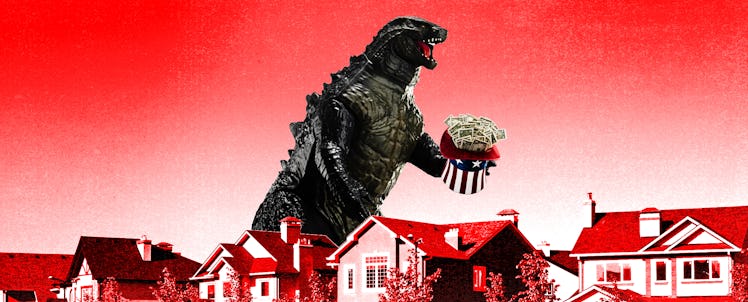American Families Bail Out Big Business Every Day, Stimulus Package Or Not
Wage stagnation over the last several decades has been nothing short of a corporate cash-grab and it's left families in the lurch.

The economy is ailing and Washington is bumbling its way to the rescue. The Senate has unanimously pushed through a $2 trillion stimulus package intended to ward off recession, which includes $150 billion to states and local governments fighting the virus, an expansion of unemployment benefits that would also be extended to contracted employees like Uber drivers, and a $25 billion bailout to airlines in the form of grants. For many millennials, Gen Xers, and, yes, Boomers, the contracted bailout negotiations smack of the 2008 financial crisis, which saw President Obama passing out some $800 billion in 2008 (and $900 billion the following year) largely to institutions deemed “too big to fail” — many of which had knowingly sold predatory loans to vulnerable consumers.
The corporate welfare state is not new, but the coronavirus stimulus package is particularly galling because of its co-authors’ intentions.
Senate Majority Leader Mitch McConnell initially floated a plan that would allow Steve Mnuchin, the Treasury Secretary, to disburse loans to big businesses without telling the public who was bailed out for six months — after the November election. Trump has signaled his comfort with some deaths in exchange for economic stabilization or growth. Texas Lieutenant Governor Dan Patrick rendered that feeling explicit, saying that “lots of grandparents” were willing to die for the economy. Though the haggled-over and agreed-upon stimulus package will alleviate some worker suffering by offering expanded unemployment benefits, direct payments to American workers, and bailouts to small business, it is also a bailout on top of a bailout on top of the invisible bailout that we don’t talk about — the one that resulted in so many American families being at so much risk right now.
Let’s talk about the end of the living wage in America. And let’s talk about wage stagnation.
In the three decades following World War II, wages for the majority of American workers rose 91 percent. That was in line with productivity, which rose at roughly the same rate. By the 1950s, the average American worker could support his family on one income. That idyll, the inspiration for so much MAGA bluster, existed during a union boom. During the heyday of the living wage, when families in the world’s richest nation lived like it, some 35 percent of American workers were represented by a union (that number is now 10 percent). That changed quickly as the information economy boomed. By the 1970s, the number of blue-collar jobs available to workers with a high school diploma was falling precipitously and white-collar wages were rising dramatically. Overall, wages flattened.
Since 1973, wages have risen just 7 percent for middle-class workers while productivity has grown 74 percent (and childcare costs have skyrocketed). In 2007, on the eve of the Great Recession, the American middle class made $17,867 less in income than would have been projected via correlations with wage growth. Meanwhile, the wage growth of the top 1 percent hovered around 138 percent.
At the same time, costs have boomed. Child care costs as much as college tuition in some states, the median cost of housing has risen to 3.7 times the average income, and ballooning healthcare costs are driving workers into bankruptcy. Not only that, American workers are paying more for basic essentials than their grandparents were while working almost twice as much. Think of all the working moms who entered the workplace. During the era of the living wage, their families would have been living high on the hog (not adjusting for sexism). But many dual-income parents struggle to get by because two wages are barely adequate for those attempting to further a child’s ambitions.
Now, because of the Coronavirus pandemic, many full-time workers are doing their jobs and childcare and wondering exactly why the corporations they have provided with so much labor so cheaply need their tax dollars as well. The answer is, in short, that companies have distributed profits to stakeholders instead of saving in the interest of their workforces. Working parents are being asked to create more value because the value they already created has been distributed to corporate shareholders. Only 49 percent of millennials own any stocks at all.
This would probably bother working parents even more if they weren’t so busy trying to keep their jobs. A Marketwatch story in 2019 noted the elimination of middle management — which began in the midst of the Great Recession in a bid to cut costs as a temporary condition — has become a broad movement, putting mid-career professionals at real risk during lean times. And there aren’t more jobs to go get.
For the past few decades, low wage job creation — lots of contract jobs without benefits — grew at a faster rate than higher-wage jobs. When measuring the health of the economy, most economists look at job creation and GDP growth rather than wage growth or wealth inequality. Things look good, but, for middle-class parents, they really aren’t — and haven’t been for a while.
As American workers sit at the kitchen table trying to maintain some sense of professional normalcy or consider how to run, let’s say, landscaping businesses while juggling their children, politicians have been burning the midnight oil ensuring that the economy will roll forward. Hopefully, they will have succeeded. Recessions are bad. But what too often goes unsaid during discussions of stimulus packages is that American companies have received the mother of all bailout from working parents, mid-career professionals too at-risk to push back on their stagnating wages even amid cost-of-living chaos.
Yes, many corporations are, in effect, too big to fail without dire consequences to the American people. That said, if the American family fails, the consequences will be far worse.
This article was originally published on